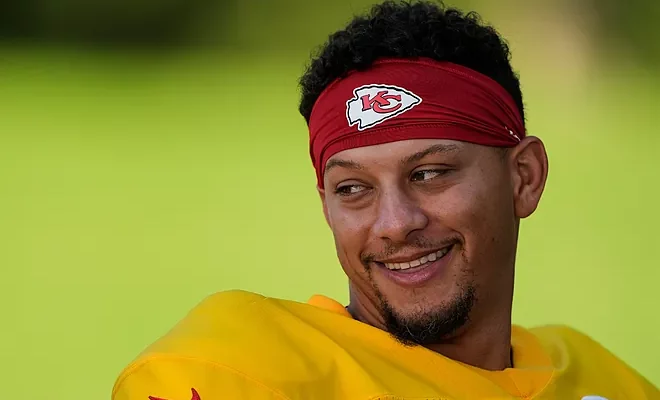Patrick Mahomes has never been one to shy away from pressure. Since taking the reins as the starting quarterback of the Kansas City Chiefs in 2018, he has redefined the ceiling for offensive firepower in the NFL. With his rocket arm, improvisational genius, and an innate feel for the game that seems preternatural, Mahomes quickly became the face of a new era of quarterbacking—one driven not just by stats and wins, but by moments of jaw-dropping brilliance that transcended the sport. And yet, as the Chiefs have evolved, so too has Mahomes’ role within the machine. In each of the last two seasons, Kansas City has leaned more heavily on its defense, and Mahomes—still elite by any measure—has posted his two worst statistical campaigns to date. Now, as the 2025 NFL season approaches, Mahomes is signaling a shift: he wants the Chiefs to rediscover their offensive dominance. And if history is any guide, that’s not just a desire—it’s a warning.
During the 2023 and 2024 seasons, Mahomes’ numbers dipped. For a quarterback who redefined statistical greatness early in his career—throwing for over 5,000 yards and 50 touchdowns in his first season as a starter—anything less than generational felt like regression. His touchdown-to-interception ratios were solid but not spectacular, and his yardage totals fell short of the 5,000-yard benchmark that had once seemed routine. Completion percentages hovered in the mid-60s, and passer ratings that once sat comfortably over 110 crept downward. In most other quarterback rooms, those numbers would be cause for celebration. In Kansas City, they were viewed with concern—and not because Mahomes had lost a step, but because the context had shifted.
The Chiefs, under head coach Andy Reid and defensive coordinator Steve Spagnuolo, had constructed a top-tier defense that could control games in ways Mahomes never needed it to in the past. In fact, many of Kansas City’s biggest wins in recent memory were built not on explosive passing plays, but on critical third-down stops, turnovers, and red zone discipline. The defense became the Chiefs’ backbone, and Mahomes, for all his magic, became more of a game manager at times—a role he filled admirably but one that muted the thunderclap offensive highlights fans had come to expect.
But Mahomes didn’t come into the league to be safe. He came to torch defenses, spin out of sacks and throw across his body for 50-yard touchdowns, to turn 3rd-and-18s into game-winning drives. That spirit hasn’t gone anywhere, even if the offense has been more conservative out of necessity. The departure of Tyreek Hill in 2022 created a void in the deep-threat department, and while Travis Kelce remains a force, age is beginning to show. The rotating cast of young receivers and inconsistent offensive line play has occasionally forced the Chiefs to tighten the reins on their offensive strategy. And yet, as Mahomes enters another pivotal season, he is making it known: the time for relying solely on defense is over.
During offseason media appearances and training camp pressers, Mahomes has emphasized a renewed focus on offensive execution. He’s praised the defense—acknowledging that without it, the Chiefs wouldn’t be the reigning back-to-back Super Bowl champions—but he’s also issued a challenge to his offensive unit. “We’ve got to take it personally,” Mahomes said during minicamp. “The defense carried us last year. That’s not who we are. We’ve set a standard here, and we’ve got to live up to it. I want us to be the team nobody wants to play—not just because of our defense, but because we’re putting up 35 every week.”
That statement resonates deeply in Kansas City. The Chiefs’ identity has always been tethered to Mahomes’ ability to dictate games with his arm. His chemistry with Kelce has become the stuff of legend, a symbiosis that often seems more psychic than strategic. But in recent years, the supporting cast hasn’t provided the same spark. Skyy Moore, Kadarius Toney, and Marquez Valdes-Scantling have all had moments, but none have consistently commanded the respect defenses gave Hill. Mahomes often found himself extending plays to create magic rather than executing designed brilliance. That wears on a quarterback—mentally, physically, and statistically.
Enter the 2025 season, and with it, a potential turning point. The Chiefs added new offensive pieces during the offseason—most notably a speedy rookie wideout with route-running polish and reliable hands. They bolstered the offensive line through the draft and free agency, giving Mahomes more time to work through progressions. And perhaps most crucially, the coaching staff has leaned into installing more vertical concepts in the passing game. Reid, ever the offensive architect, has reportedly taken a more hands-on role in daily quarterback drills, sharpening timing and communication with receivers. There’s a concerted effort to return to what made Kansas City so dangerous in the first place: unpredictability, tempo, and aggressiveness.
Mahomes thrives on rhythm, but he’s also a master of chaos. The best version of the Chiefs offense isn’t just well-scripted—it’s explosive and unrelenting. When Mahomes is on, drives don’t last long. They end in end zones. And while complementary football is the buzzword of modern NFL coaching, Mahomes understands the value of playing with a lead. Forcing opposing teams into pass-heavy catch-up mode plays right into the hands of Spagnuolo’s defense. It’s a symbiotic relationship: the better Mahomes plays, the more dangerous the defense becomes.
Still, it’s not just about numbers for Mahomes. It’s about pride. About legacy. About reasserting what the Chiefs are at their core. Even with multiple Super Bowl rings and MVP awards, Mahomes carries himself like he has something to prove. He watches film obsessively, critiques every throw, and speaks like a man chasing something just out of reach. That edge—equal parts competitive fire and perfectionism—has been the fuel behind one of the greatest starts to a career in league history. And it’s why his recent comments about offensive resurgence carry weight. Mahomes doesn’t talk just to talk. When he says it’s time to dominate again, he means it.
There are signs already that Mahomes is turning the corner statistically. During OTA scrimmages, he was sharp and decisive, reportedly completing over 75% of his passes with no turnovers and several long touchdowns. His mechanics, which had slightly degraded during stretches of last season due to pressure and off-platform throws, appear tightened. He’s stepping into throws with balance, trusting the pocket more, and showing renewed confidence in his supporting cast. If those trends carry into the regular season, the league could be on the verge of witnessing yet another reinvention of Mahomes—the surgical assassin to go with the gunslinger.
Of course, football is the ultimate team sport, and Mahomes knows that offensive improvement can’t rest solely on his shoulders. The Chiefs’ running game must be more consistent. The offensive line must stay healthy. And young receivers must develop the kind of on-field chemistry with Mahomes that made Hill and Kelce so lethal. But with No. 15 under center and a chip firmly placed on his shoulder, the odds are in Kansas City’s favor.
The danger for the rest of the NFL lies in what Mahomes’ worst looks like. Over the past two seasons, his “down” years still included multiple playoff wins, a Super Bowl MVP, and moments of late-game brilliance that would define entire careers for other quarterbacks. If that was his floor, what does his ceiling look like when paired with an elite defense and a rejuvenated offense?



